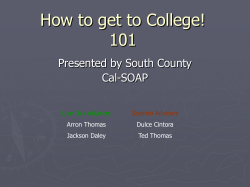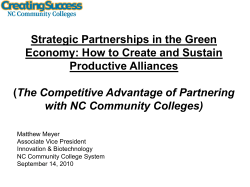
THE ROAD TO COLLEGE STARTS HERE - Cal-SOAP
+ THE ROAD TO COLLEGE STARTS HERE A College: Making It Happen presentation for Middle School students and their parents, sponsored by Cal-SOAP. + Subjects to be discussed The student role The parent/guardian role Support and resources The five systems of higher education in California Choosing a college that is right for you Making middle school coursework count The transition to high school Financial aid resources + THE ROAD TO COLLEGE… IN PERSPECTIVE + Why go to college? Greater and more diverse career options Personal and educational growth It pays off… + TIPS: The student role 1. Crack the books 2. Set your goals Strong grades and a competitive GPA are habits that must begin in middle school. Which colleges interest you? What majors will you consider? Do you have any career objectives in mind? 3. Make a plan How will you reach your goals? What kind of GPA do you need? What classes will you take in high school? What kind of extracurricular activities will you pursue? + TIPS: The student role 4. Do your research 5. Stay motivated Explore possible college and career choices: Online research: www.collegeboard.com (to be discussed) Support at school: counselors, teachers, outreach organizations Advice at home: parents, siblings, extended family It’s never too early to prepare for college. It will keep you motivated! Choose friends that share the same goals. 6. Talk to your parents Discuss your goals and plans with your parents– they can help! Consider possible high school, college, and career choices together. + TIPS: The parent/guardian role + TIPS: The parent/guardian role 1. Prioritize your child’s education 2. Celebrate achievements Create a family calendar in order to schedule homework, study, extracurricular, and recreational times. Be aware of school deadlines in order to keep your child on track. Regularly check report cards and discuss progress with your child’s teachers so you can celebrate good grades and consistent effort. Remember, your child’s motivation is the most important guide on the road to college. 3. Be involved Help choose and plan your child’s extracurricular activities. Be aware of your child’s circle of friends. + TIPS: The parent/guardian role 4. Encourage good habits 5. Talk Calendars, planners, schedules A designated study time…everyday Extracurricular activities NOW is the time for the college talk. Remember, colleges will consider your child’s work from day one of high school to graduation day. Ask questions: What are your child’s career interests? Favorite subjects? Weakest subjects? Seek resources Look for school and community resources in order to build a support network for your child’s success… + The college talk begins…NOW! We will now take a 30 second break… PARENTS/GUARDIANS: Turn to your students and ask them one or all of the following questions: 1) Where do you want to go to college (i.e. possible campuses, cities, states)? 2) What careers are you interested in? 3) What are your strongest and weakest subjects in school? + Building a support network The College Team: Who’s in it? The student, of course! Family matters: parents/guardians, siblings, extended family Good friends– with shared goals School staff: teachers, counselors Local outreach organizations…like Cal-SOAP! + Seek resources…because we all need a little help Encourage your child to join an after school program that supports a college-going culture. Finding a program: School: talk to teachers, counselors, and principals Community organizations– i.e. libraries, recreational centers, religious institutions Research programs and advice online with the After School Alliance: www.afterschoolalliance.org (Click on “After School in My Community”) Seek the services of educational outreach organizations that may be present in your middle schools or high schools. Cal-SOAP, TRIO, UPWARD BOUND, GEAR-UP, EAOP, etc. + DISCLAIMER: The times, they are a-changin’ The most important tip of all for students and parents: Do your research and remain up-to-date with college requirements. Recent changes (announced in 2009) have affected: The UC testing requirement The UC Eligibility in the Local Context GPA range The impaction of majors in select CSU campuses The Transfer Agreement Guarantee program at the CSU Tuition fees at all California public campuses, including community colleges Disclaimer: All requirements discussed today, apply only today. It is your responsibility to remain aware. Let’s learn about some colleges… + THE 5 SYSTEMS OF HIGHER EDUCATION IN CALIFORNIA AND THEIR REQUIREMENTS + Requirements: A cheat sheet for college acronyms GPA- Grade Point Average AP- Advanced Placement Optional courses in high school that offer college credit, if students pass a final examination “A-G” Colleges will ask for either the student’s weighted (extra points for honors/AP courses) or unweighted GPA A curriculum of University of California (UC) approved general education courses, listed A-G, that must be completed in high school for college entrance Standardized Tests: SAT- Scholastic Aptitude Test (a.k.a. SAT Reasoning Exam) ACT- American College Test Most universities require scores from either the SAT or ACT What’s the difference? SAT Subject Subject-specific exams that some private universities may require or recommend (i.e. Spanish, US History, Literature, etc.) + University of California Stats: 10 campuses Research-based Approximately $27,000 per year for total fees Basic admission requirements: A-G coursework 3.0 GPA SAT or ACT SAT Subject Update: Beginning with the senior class of 2012, the SAT Subject exams are no longer required (but recommended) “Comprehensive/Holistic Review” Important factors: extracurricular activities, leadership roles, community service, etc. Transfer Agreement Guarantee for CA Community College students + California State University Stats: 23 campuses Traditional university setting Approximately $15,000 per year for total fees Basic admission requirements: A-G coursework Meet minimum eligibility index (a number derived from an equation that considers both GPA and SAT/ACT scores) SAT or ACT Transfer Agreement Guarantee for CA Community College students + California Community College Stats: 112 campuses Transfer, Associate’s Degree, vocational, and certificate programs available Approximately $2,000 per year for total fees Basic admission requirements: High school diploma or GED or 18 years old (Note: High school students can enroll in community college classes with high school’s approval.) + Private Colleges Stats: Many, many campuses (i.e. University of San Diego, Point Loma Nazarene University, Stanford University, National University) Campus settings/focuses vary widely Costs vary widely Basic admission requirements: Vary, but generally accept courses covered by the A-G curriculum GPA varies, but generally selective Testing requirements vary, but generally require SAT or ACT (SAT Subject exams may be required or recommended, depending on campus and major) Transfer requirements and programs vary Generally practice Holistic Review Extracurricular activities, leadership roles, and community service considered + Vocational/Technical Institutions Stats: Many campuses, depending on field of study (i.e. Art Institute of San Diego, FIDM, Paul Mitchell School, Universal Technical Institute, Concorde Career Institute) Degrees and/or certificates available Costs vary widely Basic admission requirements: Admission requirements vary widely. Research application procedures at each program of interest. (Note: Many vocational programs are available at community colleges for a much lesser cost.) + CHOOSING A COLLEGE THAT IS RIGHT FOR YOU… COLLEGE EXPLORATION BEGINS TODAY + Make-or-break criteria A few, basic factors to consider when researching college campuses… Institution type (public, private, vocational) Majors/minors offered Campus/enrollment size (large vs. small classes) Campus reputation Geography (urban/rural; in-state/out-of-state) Distance from home Housing (available/guaranteed?) Campus resources (libraries, computers) Costs (tuition, books, room and board) Financial aid offered + Make-or-break criteria Some more factors to consider… Tips for successful research: Religious affiliation Gender-specific vs. co-ed Student body diversity Extracurricular activities offered Social life (sororities, fraternities, clubs) Begin to visit campuses as early as possible. Don’t rely on name recognition/hype. Find your best fit! Don’t pick campuses just because your friends are applying. Make your own decisions! Don’t rule out colleges because of cost. Financial aid is available. Online research: College Board “Profiles” and “Matchmaker”: www.collegeboard.com + MAKING MIDDLE SCHOOL COUNT: PREPARING EARLY FOR COLLEGE + Did you know? There are two courses that middle school students can take for A-G credit NOW: Algebra 1 Foreign Language Spanish, French, Cantonese, etc. …BUT, you must earn at least an ‘A’ or ‘B’ in order to prevent repeating the course in high school. + Middle School Checklist 6th Grade: Take challenging classes to help prepare yourself for high school Begin the college talk with your parents Start a calendar of homework and activities Teach yourself good study habits now! Encourage your parents to start saving for your college education 7th Grade: Enroll in Algebra and a foreign language– they count for A-G credit! Perform well on standardized tests– they’re good practice for the CAHSEE and SAT/ACT If you need help, seek a counselor/teacher/tutor NOW– don’t wait! 8th Grade: Ask your parent/guardian to help you research colleges and careers: www.collegeboard.com Research financial aid options with your parents: www.fafsa4caster.ed.gov Talk to your parents about choosing a high school Become involved in school or community activities that will let you explore career interests + THE WONDERFUL TRANSITION TO HIGH SCHOOL PLANNING YOUR NEXT FOUR YEARS + The notorious “A-G” 2 years a) History and Social Science 4 years b) English 3 years (4 years rec.) c) Mathematics (algebra, geometry, and algebra II) 2 years (3 years rec.) d) Laboratory Science (1 year of biological science and 1 year of physical science) 2 years (3 years rec.) e) Foreign language (both years must be in the same language) 1 year f) Visual and performing arts (art, dance, theatre/ drama, or music) 1 year g) Elective chosen from the subject areas listed above or other college preparatory course (2 semesters or 1 year-long course) In order to find a unique list of A-G courses approved for your high school, visit the UCOP Pathways website: https://doorways.ucop.edu/list/ + Five tips for high school success 1. Make sure you take a healthy number of A-G courses every year– in addition to your high school requirements and electives. Passing may mean a “C” 2. Show progress and diversity in your coursework. 3. Talk to your counselor every semester! The big question to ask: “Am I on track to apply for ____ college(s)?” 4. Work on your “application builders”: If you excel in a subject, take its Honors/AP level. Extracurricular activities: clubs, sports, student government Leadership roles Community service 5. Balance your school work and social life with college preparation, i.e.: SAT/ACT preparation and examination College research Scholarship searches and applications + FINANCIAL AID RESOURCES (PARENTS: LISTEN CLOSELY!) + Money, money, money Government grants/loans: Campus-based grants and scholarships: Apply for the FAFSA by March 2 of your senior year in high school Apply with your admission application and/or once enrolled in college Scholarships: You should begin applying in middle school and not stop till you have a college degree! Online search engines: www.fastweb.com ; www.cashe.com ; www.collegeboard.com ; www.scholarships.com ; www.maldef.org School/community resources: counselors, teachers, peers, career centers, public libraries, community organizations, etc. Financial aid is available for everyone! Undocumented students, foster youth, and veterans’ dependents should talk to a counselor or Cal-SOAP representative in high school. + Money, money, money Tips for scholarship success—Start NOW: Apply for as many scholarships as possible Don’t neglect smaller, local scholarships Bridge multiple applications Recycle, recycle, recycle Paint a strong self-portrait in scholarship essays Keep a written personal inventory Prioritize school work and class time Stick with it + The road to college… starts here, today When you need directions, contact Cal-SOAP: Online: www.sandiegocalsoap.com Phone: (858) 569-1866
© Copyright 2025















